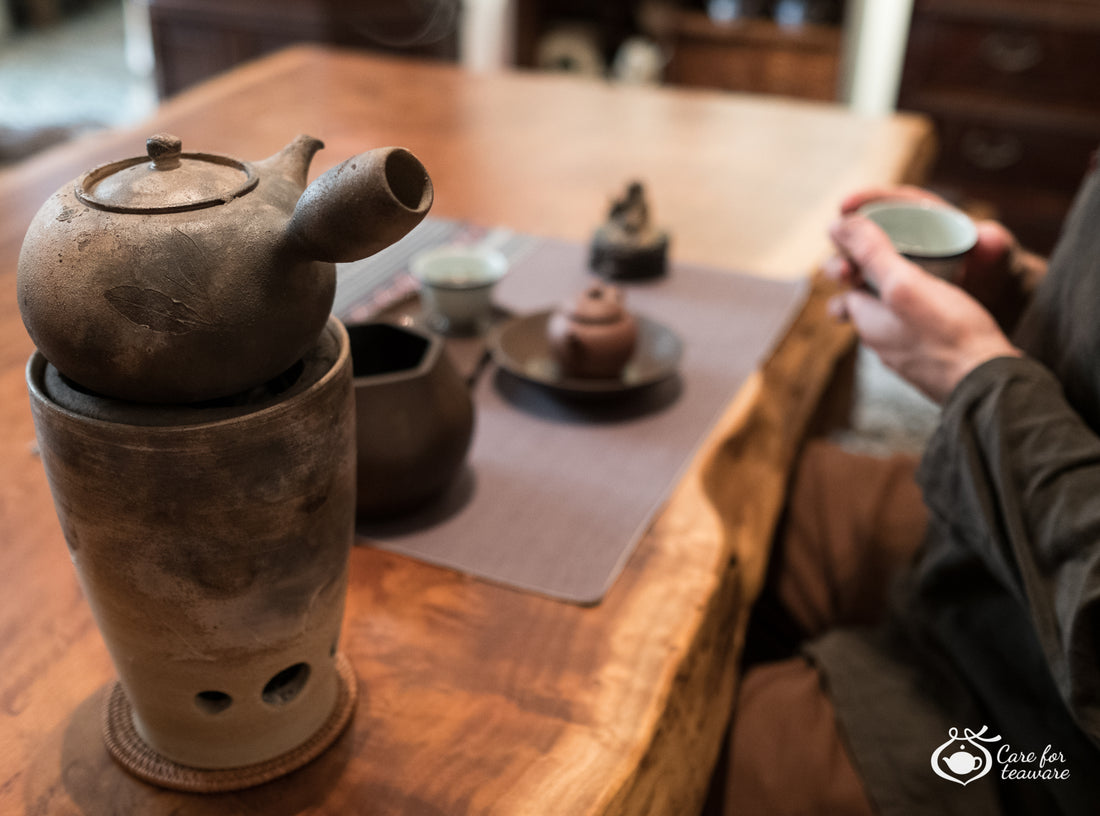
A Guide to Chabu: Choosing the Perfect Tea Runner
What is a Chabu?
A chabu is a fabric that would serve as a colorful background, base and basis for the upcoming tea day. While it’s often a cloth runner, a chabu can also be made from bamboo mats, wood, stone, or other materials. Since fabric chabu are the most common, I'll focus on them here.
Traditionally, tea runners are used in tea ceremonies, often placed on a table or floor to add elegance and mindfulness to the tea space. Chabu are typically made from natural fabrics like cotton, silk, or linen, including vintage materials, which bring a sense of history and artistry to one’s tea practice. They not only protect the surface underneath but also deepen the overall experience by setting the tone and atmosphere for the ceremony.
This guide is practical and straightforward. For deeper philosophical insights, check out my other articles.

How to Choose a Chabu
Choosing the right chabu can seem overwhelming at first, but by considering a few key factors, you can find the perfect one for your tea practice today. While fabric can handle some drops, it’s best to keep spills to a minimum. Unlike a bamboo tray, this may seem like a drawback, but it’s actually an incentive to be more focused and precise with your pouring. Concentration helps you pay attention to details, make better tea, and enjoy it more thoroughly. Spils give you immediate feedback and help improve your technique. So, a chabu isn’t just about aesthetics—it’s functional too.

1. Consider Your Brewing Method: Gongfu or Bowl Tea
The type of tea ceremony you practice can influence your choice of chabu:
Gongfu Tea: This method involves small teaware, requiring an organized space for the teapot, cups, and other tools. “Gongfu cha” literally means “right effort put into tea.” It’s a ritual that has existed for hundreds of years, refining the exact movements needed to make the best cup of tea possible. Everything has its right place and proportion. A wider chabu may be ideal, providing enough room to organize your setup neatly. This is especially helpful if your tea space is limited or you prefer a minimalist aesthetic. In Gongfu, the chabu serves as a grounding layer beneath the teapot, collecting spills and drops.
Bowl Tea: Simpler and more meditative, bowl tea often gives more freedom for personal expression. You can use a smaller or larger chabu or layer multiple chabu on top of each other. I like to highlight an area with a ribbon-like chabu—a strip of colorful fabric underneath the teapot and bowls that unites the space and creates a light, airy feeling.

2. Think About the Number of Guests
The size of your chabu might reflect the number of people participating in the tea ceremony:
Solo or Small Group: If you’re hosting tea for yourself or just one or two others, a smaller or medium-sized chabu will be enough to accommodate your teaware.
Larger Gatherings: For larger groups, consider a more extended chabu that can comfortably fit the additional teaware and create a welcoming environment for your guests.

3. Match the Size to Your Tea Table or Floor Space
Whether you’re setting up on a table or directly on the floor, the size of your chabu should harmonize with the available space:
Tabletop: Measure your tea table before choosing a chabu. It should cover enough of the surface to protect it and create a defined area for your tea setup.
Floor: If you prefer sitting on the floor, make sure your chabu fits comfortably within your seating area. A larger chabu can act as both a practical surface and a decorative focal point.

4. Aesthetics
Right in front of us is a stone, wooden, glass or metal surface. It is rough or smooth; warm or cold; it is acoustically dead or resonant, glossy or matte; it is transparent, opaque, patterned or with color. All of these elements will then be part of our tea, the background of the performance or the canvas on which our painting will be created. The most important question then becomes: What do you want it to be? What stage will create the right mood and atmosphere to bring out the tea in the best possible way? When we answer this question, it gives us a sense of direction.
A beautiful tea runner adds elegance and color to any chaxi (tea stage). The variety of colors and designs can create very different atmospheres for your chaxi.
Color. A long blue one might be part of a theme with a river or the sky, a maroon or orange hue might remind us of monk's robes and mindfulness. It is a bit like the canvas upon which the tea session is painted. All the rest of the teaware must be in harmony with the canvas on which they are placed, or the whole session will be disharmonious. When I first started creating tea stages, I liked bright colors, but over time, I realized that subdued colors and muted tones create a calm, peaceful atmosphere that’s easier to work with.
Pattern. Patterns add rhythm and can be fun to play with, but they can also be tricky. Bold patterns can overpower everything else, making any teaware placed on top of them invisible or lost. Choose a pattern that reflects the mood you want to create during your tea ceremony.
Material: The fabric of the chabu can also influence the atmosphere. Silk or other fine materials bring a sense of gentleness, while more rustic fabrics like linen or cotton offer a more casual and earthy vibe.
Overall, chabu plays a big role in how your tea space will look like – simple, elegant or rustic, colorful or pale.

Conclusion
The chabu or tea runner/cloth is often one of the first elements we consider. It plays a huge role in determining whether your chaxi will be rustic or elegant, simple or refined. Chabu can be made from cloth, bamboo, woven sticks, rattan, straw, and other materials. They vary greatly in shape, color, and pattern.
When you choose a chabu, it will quite literally lay the foundation for your tea ceremony, as all other elements will find their place upon it. You could also choose to use a piece of wood or stone, something unique, or even nothing at all.
Choosing the right chabu is about more than just aesthetics; it’s about finding a piece that enhances your tea practice, complements your space, and brings joy to your tea moments. By considering your brewing method, the number of participants, the size of your table or floor space, and your personal style, you can select a chabu that’s perfect for you. As you explore the world of tea, let your chabu be a reflection of your journey—a symbol of tradition, mindfulness, and beauty.
